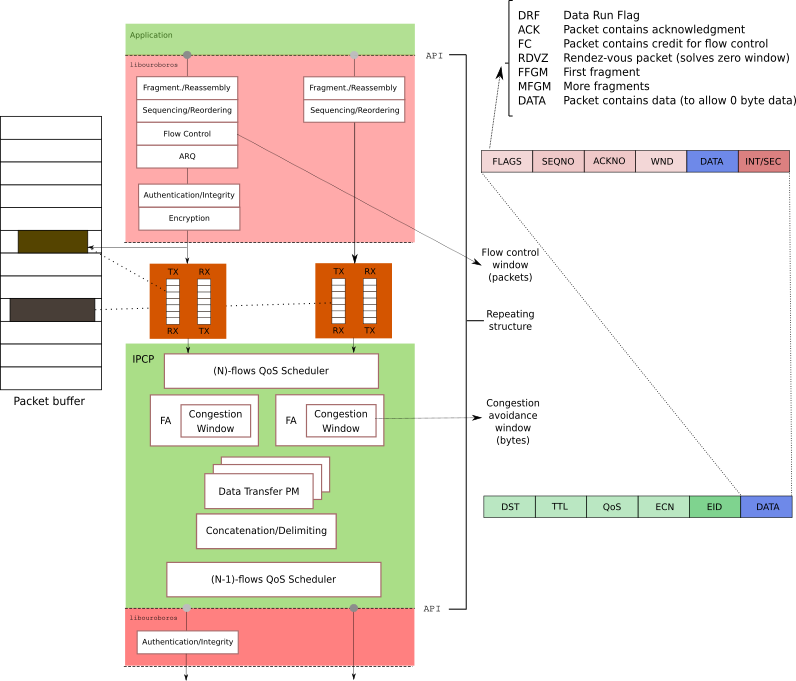The Ouroboros datapath (unicast)
The Ouroboros datapath is responsibe for all key functions that allow Ouroboros to transfer data reliably, securely and privately from one process to another. So, in essence, to perform Inter-Process Communication. How this datapath is bootstrapped is covered in the Flow Allocation section.
This page provides an overview of the journey of a piece of data that is sent over Ouroboros. It covers one layer in the recursive network.

The flow_alloc() call bootstraps the datapath and configures which functions will be performed on the packet. This will be symmetrical at the receiver side and sender side. The way this is is done is based on a qos parameter. We won’t go into all its details here, but in essence it allows enabling or disabling some end-to-end functions.
These functions are
fragmentation/reassembly: when the data is too big for the network to transport in one chunck, it will first be chopped into smaller pieces, and reassembled at the endpoint. The maximum limit is calculated by the IPCP as part of flow allocation. There are two bits used for fragmentation, a first fragment bit, and a more fragments bit.
sequencing/reordering: packets are assigned a sequence number so they can be delivered in the same order as they are sent. Sequence numbers increase by 1 per fragment.
flow control: this prevents the source process from sending faster than the receiving process can handle1.
automated repeat/request (ARQ): When a packet is received, the receiver will send and acknowledgment (ACK). If an acknowledmgent is not received in a certain timeframe (based on the estimated round-trip time and its standard deviation), the sender will retransmit it.
The above four functions are grouped together in the FRCP transport protocol. The protocol can be disabled in its entirety: Ouroboros delivers packets as they arrive, doesn’t recover lost packets, drops packets that are too big, etc.). When FRCP is disabled, the headers are not even added to the packet. From the perspective of the endpoints, this is similar in service to UDP/IP. Or some functions can be disabled separately, such as ARQ, then you have something like UDP but with flow control. We will not go into the details of the operation of FRCP here.
- authentication: A message authentication code is appended to the message.
- encryption: The message is encrypted before sending.
These two functions (authentication/encryption) can be enabled or disabled separately and enabling both should allow Encrypt-then-MAC, Encrypt-and-MAC and MAC-and-encrypt2.
All the above functions are implemented in the Ouroboros library. So they are executed by the application.
Let’s start with the downstream path, i.e. sending a piece of data. The data will be transported in the form of a packet. The first thing that happens is that the packet is copied to the packet buffer and ownership is transferred to Ouroboros. Then an FRCP header may be added, the FRCP state machine will be updated (e.g. flow control windows, next sequence number, last acknowledged sequence number etc), and MAC/Encryption may be performed.
Now the packet is passed over the flow endpoint (the TX/RX FIFO’s in the figure) to the (unicast) IPCP.
The unicast IPCP implements a layer, and it reads packets coming from flows allocated by the layer (or application) above – referred to as the (N+1)-flows – and then forwards to other relaying IPCPs in the layer, using the layer below (referred to as (N-1)-flows.
Now, remember the qos parameter? It not only enables or disables functions related to FRCP or authentication/encryption, it also allows some prioritization of packets. The IPCP has a two schedulers, one that reads packets from the N+1 flows and another that reads packets from N-1 flows.
Next it passes through congestion control. The DT protocol (implemented in the Data Transfer Protocol Machine) has an ECN field that is updated according to the depth of the outgoing flow queue. The TX/RX queues between the layer keep track of how many packets they have queued. If a packet is queued into a queue that has a lot of packets, the ECN field is updated. This is adjustable per QoS level. For instance, packets with a high QoS may get an ECN increase of 1 and packets with low QoS may get an ECN increase of 8 if the queue is quarter full. When a receiving IPCP sees high ECN values, it will send a message to the sending IPCP. This scheme is commonly known as Forward Excplicit Congestion Notification (FECN). Data Center TCP also uses this approach. The congestion window operates in bytes because network bandwidth is in bytes/s).
Finally, if the IPCP is receiving a lot of small packets, it will also group them together into larger packets. We do this here (and not in FRCP) because it’s more efficient: the IPCP can group packets from many different flows towards the same destination.
And then the cycle repeats: the packets are send according to the same process to the layer below. One difference is that when an (N)-IPCP an (N-1)-IPCP, it will avoids a copy, and only pass a reference to the packet in the packet buffer.
While all these functions are potentially present in every layer, this does not mean they must be present or enabled in every layer. Think of Ouroboros layers as humans: all are equal, none are identical.